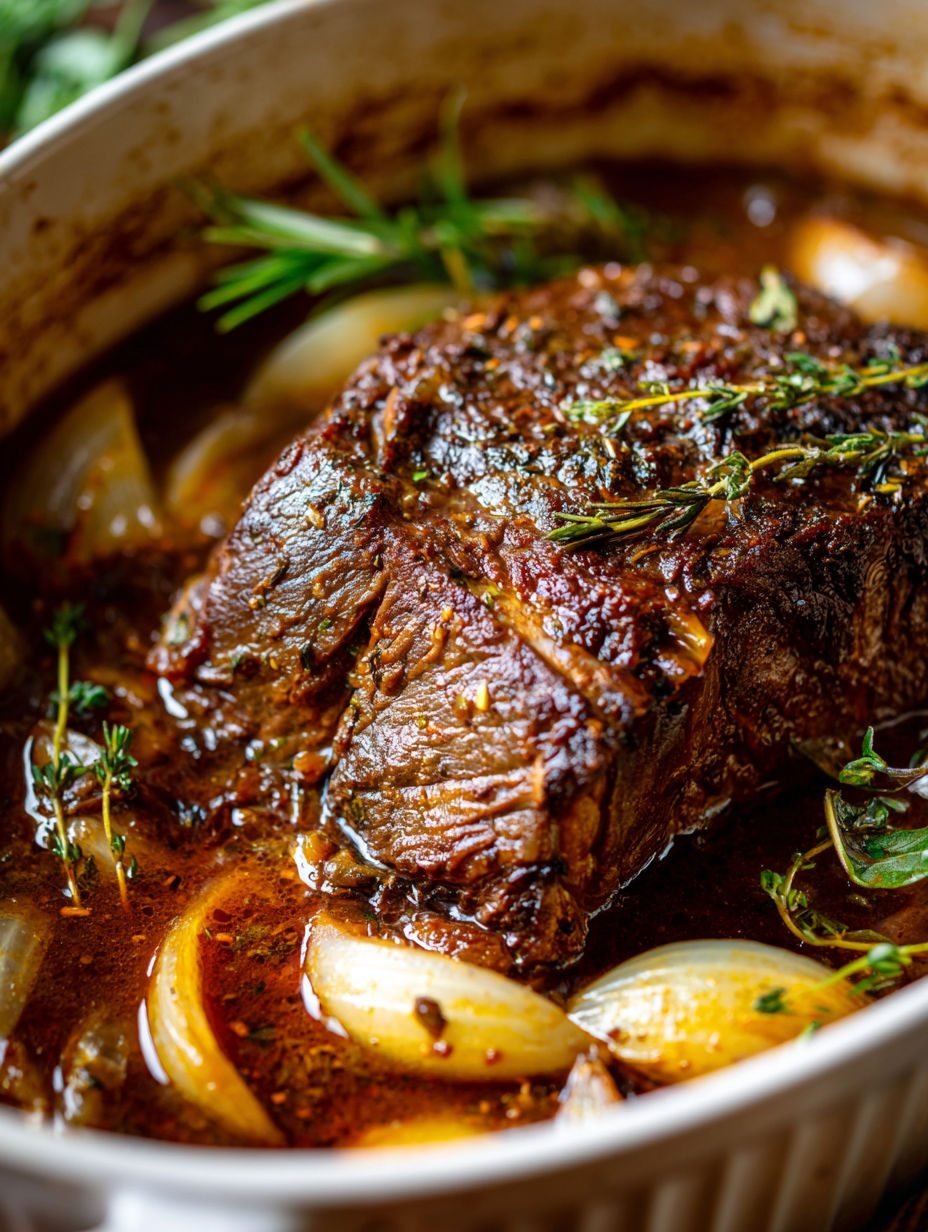 Bookmark
Bookmark
This apple cider braised pork shoulder captures all the cozy flavors of fall in one hearty dish. Slow cooking breaks down the pork into tender, melt-in-your-mouth pieces that soak up the sweet and tangy apple cider, softened onions, and fresh herbs. The addition of tart apple slices brightens the rich pork, making every bite perfectly balanced and comforting. This recipe works beautifully whether served as a dinner main, shredded into sandwiches, or tucked into soft tacos.
I first made this recipe when the apple harvest was at its peak and fell in love immediately. It has since become a go-to for chilly weekends, filling the house with a warm, inviting aroma that my whole family adores.
Ingredients
- Pork shoulder: about three to four pounds for optimal tenderness and fat content choose bonein for extra flavor or boneless for convenience
- Salt and freshly ground black pepper: key for seasoning and enhancing natural pork flavors
- Olive oil: for searing ensures a beautiful crust and locks in juices
- Onions: thinly sliced to caramelize and add sweetness
- Garlic cloves: smashed or chopped to bring depth and aroma
- Apple cider: preferably fresh and unsweetened to create the signature braising liquid
- Chicken stock or broth: adds savory body to balance the cider’s sweetness
- Apple cider vinegar: provides brightness and cut through the richness
- Firm apples: such as Granny Smith or Honeycrisp that hold shape and add a bright, tart contrast
- Fresh herbs: like thyme rosemary and bay leaves to infuse earthy flavor
- Optional Dijon mustard: for a subtle tang and complexity
- Butter or oil: for finishing the sauce and enriching the final dish
Instructions
- Preheat and season:
- Preheat your oven to around 325 degrees Fahrenheit or about 160 to 165 degrees Celsius. Pat the pork shoulder completely dry to ensure proper browning and season generously on all sides with salt and black pepper. Allow the seasoning to soak in briefly while you prepare your cooking vessel.
- Sear the pork:
- Heat olive oil in a heavy Dutch oven or an ovensafe pot over mediumhigh heat until shimmering. Carefully place the pork shoulder into the pot and sear it on all sides for about three to four minutes each until deeply browned. This step builds flavor through the Maillard reaction giving the pork a rich crust. Remove the pork and set it aside on a plate.
- Sauté aromatics:
- In the same pot use the rendered fat and remaining oil to add the thinly sliced onions. Cook them over medium heat until they become soft and begin to caramelize which usually takes around ten to fifteen minutes. Add the finely chopped or smashed garlic and stir constantly for about thirty seconds until fragrant but not burnt.
- Deglaze and build braising liquid:
- Pour in the apple cider followed by the chicken stock. Use a wooden spoon or spatula to scrape up all the flavorful browned bits stuck to the bottom of the pot this adds depth to the sauce. Stir in the apple cider vinegar and, if using, the Dijon mustard. Bring the mixture to a gentle simmer on the stovetop.
- Return pork and add apples and herbs:
- Carefully place the seared pork shoulder back into the pot nestling it down into the liquid. Arrange the sliced apples around the pork and tuck fresh herb sprigs such as thyme rosemary and bay leaves into the braising liquid. The liquid should cover about halfway up the meat to ensure even cooking and moisture.
- Cover and braise:
- Cover the pot tightly with a lid and transfer it to the preheated oven. Let the pork braise gently for approximately two to three hours until it is almost tender and easily pierced with a fork. Add any remaining apples if you have reserved them and continue cooking for an additional thirty to sixty minutes until the meat is easily shredded.
- Rest and shred:
- Remove the pot from the oven and let the pork rest in the braising liquid for ten to fifteen minutes. This resting period allows the meat to reabsorb some juices making it moist and flavorful. Remove and discard the herb sprigs then shred or slice the pork as desired.
- Finish the sauce:
- Place the pot back on the stovetop over medium heat to reduce the braising liquid to a slightly thickened sauce about five to ten minutes. Spoon this sauce generously over your pulled pork or sliced pieces when serving.

My favorite part of this recipe has to be the fresh apple slices added to the braising pot. They soak up the sweet and savory liquid and maintain a gentle bite that contrasts beautifully with the tender pork. I remember serving this to close friends on a chilly autumn evening and how their smiles said everything about the comforting magic of this dish.
Storage Tips
Store any leftovers in airtight containers in the refrigerator up to four days keeping both pork and sauce together. For longer storage cool the pork and sauce completely before freezing in portioned containers for up to three months. Reheat slowly on the stove adding a splash of broth or water to loosen thickened sauce and prevent sticking.
Ingredient Substitutions
Use boneless pork shoulder if you prefer faster cooking but note that bonein enriches flavor and moisture. Chicken stock can be swapped with vegetable stock or even water with bouillon in a pinch. Replace apple cider vinegar with white wine vinegar or lemon juice for a different type of acidity. Herbs such as sage marjoram or oregano can substitute thyme or rosemary to vary the herbal profile. If you do not have apples try pears or quince which also pair wonderfully with pork while offering a mild change in flavor.
Serving Suggestions
Serve this pork over creamy mashed potatoes buttery polenta or alongside roasted root vegetables and Brussels sprouts for a hearty fall meal. Pulled pork sandwiches with coleslaw pickles or spicy mustard make an easy and crowd pleasing option. Pair the rich pork with a crisp green salad or sautéed bitter greens to balance the richness and round out the meal.

This pork is perfect for cozy dinners and makes excellent leftovers; warm and serve with mashed potatoes or in sandwiches for a comforting meal.
Common Recipe Questions
- → Can apple juice be used instead of cider?
Apple juice can substitute, but cider offers richer flavor and a balanced sweetness. Adding a dash of cider vinegar helps enhance tang if using juice.
- → How long do leftovers stay fresh?
Stored properly in airtight containers, leftovers remain good in the refrigerator for about four days.
- → Is this suitable for slow cooker preparation?
Yes, after searing, transfer to a slow cooker and cook on low for 6–8 hours or high for 3–4 hours for tender results.
- → Can the braising sauce be thickened?
The sauce can be reduced on the stovetop or thickened with a cornstarch slurry (equal parts cornstarch and water) simmered until desired consistency.
- → What type of apples work best for braising?
Firm apples like Granny Smith or Honeycrisp are ideal, as they hold shape during cooking and add pleasant acidity and texture.
- → How important is searing the meat first?
Searing develops deep color and flavor, creating a richer base before slow cooking, and is highly recommended.
